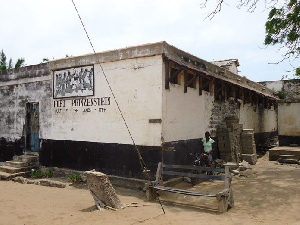The TV3 New Day team in collaboration with Tour Operators Union of Ghana in a video documentary showed that the fort is gradually crumbling without any interventions to revamp it.
The team embarked on a familiarization tour to be able to direct both local and international tourists to various tourist sites.
History of the Fort
Speaking to the tour guide at the fort, Mr Mensah (not his real name) said the fort was initially built by Danish traders in 1784 for defensive purposes in a war against the Anlo Ewe and to keep the area safe from other colonial powers.
He further stated that the fort was also used as a dungeon for slaves who were awaiting transportation to Caribbean.
The tour guide said, “slaves were transported from Togo to the Fort because it is in the Volta region and closer to Togo.”
He revealed that each room in the dungeon was occupied with about 100 to 200 slaves with unfavorable living conditions, adding the female dungeon is completely destroyed due to the sea breeze.
“The slave trade was so severe that some were even people in very smaller towns were captured to be sold out”.
The tour guide explained that the Fort was built about 84 years ago and that the sea-breeze contributed to the gradual deteriorating of the building.
Mr Mensah stated that “the fort was used as a prison for a period of time before it was partially destroyed by the sea in 1980.”
He explained that shea butter was used to rub the bodies of slaves to make them look attractive to buyers.
Also, the ages of slaves were determined by the conditions of their teeth. Slaves with fully-set teeth were pronounced to be young and slaves with unhealthy teeth were pronounced as old.
“Children were also part of the trade and they were able to detect their ages by their size and conditions of their tooth,” he added.
The tour guide said trees were planted all around the fort to make it complicated for slaves to escape.
“Slaves who tried to escape get entangled with branches of trees and were severely punished to detest the others from escaping.”
You should take into consideration, travelling to the Volta region on your next tourist tour to see the remains of Fort Prinzenstein and some other tourists sites.
 Home Of Ghana News Ghana News, Entertainment And More
Home Of Ghana News Ghana News, Entertainment And More





